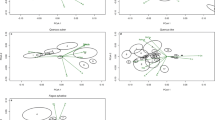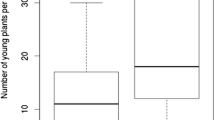Abstract
Huckleberries are major components of the understory vegetation in coniferous Pacific Northwest forests of the United States. Vaccinium species also have a long history of human use. However, little research has been done to ascertain how they respond to common forest management practices. We used data obtained from old-growth, young thinned, and young unthinned Douglas-fir stands in western Oregon to evaluate how forest management could potentially influence species abundance and product supply. Our analysis focused on three species: Vaccinium ovatum, V. parvifolium,and V. membranaceum. Results were variable, but indicate that overstory stand conditions and forest management can affect huckleberry species abundance. However, to assess fully the effects of forest management on these species, studies specifically designed to target areas where people harvest these products are needed. Measuring relevant product attributes such as commercial productivity is also critical.
Similar content being viewed by others
Literature Cited
Alaback, P. B., and F. R. Herman. 1988. Long-term response of understory vegetation to stand density inPicea—Tsuga forests. Canadian Journal of Forest Research 18:1522–1530.
Bailey, J. D., and J. C. Tappeiner. 1998. Effects of thinning on structural development in 40- to 100-year-old Douglas-fir stands in western Oregon. Forest Ecology and Management 108:99–113.
—,C. Mayrsohn, P. S. Doescher, E. St. Pierre, and J. C. Tappeiner. 1998. Understory vegetation in old and young Douglas-fir forests of western Oregon. Forest Ecology and Management 112: 289–302.
Barbour, M. G., J. H. Burk, W. D. Pitts, F. S. Gillian, and M. W. Schwartz. 1998. Terrestrial plant ecology. Benjamin/Cummings, Menlo Park, CA.
Blatner, K. A., and S. Alexander. 1998. Recent price trends for non-timber forest products in the Pacific Northwest. Forest Products Journal 48:28–33.
—,and W. E. Schlosser. 1997. The floral and Christmas green industry of the Pacific Northwest. Project report to the USDA Forest Service PNW Research Station, Portland, OR.
Breakey, E. P. 1960. The blackheaded fireworm of cranberry—a pest of the evergreen huckleberry in western Washington. Economic Botany 53:1097–1099.
Carey, A. B. 1995. Sciurids in Pacific Northwest managed and old-growth forests. Ecological Applications 5:648–661.
—,and M. L. Johnson. 1995. Small mammals in managed, naturally young, and old-growth forests. Ecological Applications 5:336–352.
—,J. Kershner, B. Biswell, andL. Dominguez De Toledo. 1999. Ecological scale and forest development: Squirrels, dietary fungi, and vascular plants in managed and unmanaged forest. Wildlife Monographs 63:1–71.
Carroll, M. S., K. A. Blatner, and P. Cohn. (n.d.) Somewhere between: Social embeddedness of “recreational” and “commercial” huckleberry use. Rural Sociology (accepted).
Chaney, C. C. 1990. Managing wild blueberries for recreation on the Chippewa National Forest. Report to the Chippewa National Forest, Cass Lake, MN.
Covington, W. W., P. Z. Fulé, M. M. Moore, S. C. Hart, T. E. Kolb, J. N. Mast, S. S. Sackett, and M. R. Wagner. 1997. Restoration of ecosystem health in southwestern ponderosa pine forests. Journal of Forestry 95:25–29.
Cronemiller, L. F., J. B. Woods, C. H. Ladd, A. Parker, E. D. Hanneman, A. H. Sasser, C. W. Maus, andW. S. Phelps. 1951. Secret treasures in the forest. Bulletin 14. Oregon State Board of Forestry, Salem, OR.
Curtis, R. O., and A. B. Carey. 1996. Timber supply in the Pacific Northwest. Managing for economic and ecological values in Douglas-fir forests. Journal of Forestry 94:5–7; 35-37.
Douglass, B. S. 1975. Floral greenery from Pacific Northwest forests. USDA Forest Service, Pacific Northwest Region, Portland, OR.
Findley, A. J., M. S. Carroll, andK. A. Blatner. 2000. Social assessment for the Colville National Forest CROP program. USDA Forest Service, Pacific Northwest Research Station, PNW-GTR-499, Portland, OR.
Fisher, A. H. 1997. The 1932 handshake agreement: Yakama Indian treaty rights and Forest Service policy in the Pacific Northwest. Western Historical Quarterly 28:187–217.
Franklin, J. F., and C. T. Dyrness. 1988. Natural vegetation of Oregon and Washington. Oregon State University Press, Corvallis, OR. (Originally published 1973 by the USDA Forest Service, PNW-GTR-8.)
—,and T. A. Spies. 1991. Composition, function, and structure of old-growth Douglas-fir forests. Pages 71–91 in L. F Ruggiero, K. B. Aubry, A. B. Carey, and M. H. Huff, eds., Wildlife and vegetation of unmanaged Douglas-fir forests. USDA Forest Service, Pacific Northwest Research Station, PNW-GTR-285, Portland, OR.
Grime, J. P. 1979. Plant strategies and vegetation processes. John Wiley & Sons, Ltd., New York.
Halpern, C. B., andT. A. Spies. 1995. Plant species diversity in natural and managed forests of the Pacific Northwest. Ecological Applications 5:913–934.
Hansen, A. J., T. A. Spies, F. J. Swanson, andJ. L. Ohmann. 1991. Conserving biodiversity in managed forests, lessons from natural forests. Bioscience 41:382–392.
Harrington, C. A., K. R. Buermeyer, L. C. Brodie, andB. W. Wender. 2002. Factors influencing growth and flowering of understory plants in conifer stands in western Washington. Pages 159–168 in A. C. Johnson, R. W. Haynes, and R. A. Monserud, eds., Congruent management of multiple resources: Proceedings of the Wood Compatibility Initiative Workshop. USDA Forest Service, Pacific Northwest Research Station, PNW-GTR-563, Portland, OR.
Howell, D. C. 1992. Statistical methods for psychology, 3rd Edition. Duxbury Press, Belmont, CA.
Huffman, D. W., J. C. Tappeiner II, andC. Zasada.1994. Regeneration of salal(Gaultheria shallon) in the central Coast Range forests of Oregon. Canadian Journal of Botany 72:39–51.
Hunn, E. S., and H. H. Norton. 1984. Impact of Mt. St. Helens ashfall on fruit yield of mountain huckleberry,Vaccinium membraneceum, important native American food. Economic Botany 38:121–127.
Klinka, K., H. Y. H. Chen, Q. Wang, andL. de Montigny. 1996. Forest canopies and their influence on understory vegetation in early seral stands on West Vancouver Island. Northwest Science 70: 193–200.
Minore, D. 1972. The wild huckleberries of Oregon and Washington—a dwindling resource. USDA Forest Service, Pacific Northwest Research Station, RP-322, Portland, OR.
—. 1984.Vaccinium membranaceum berry production seven years after treatment to reduce overstory tree canopies. Northwest Science 58:208–212.
—,and M. Dubrasich. 1978. Big huckleberry abundance as related to environment and associated vegetation near Mount Adams, Washington. USDA Forest Service, Pacific Northwest Research Station, Res. Note PNW-322, Portland, OR.
—,A. W. Smart, and M. E. Dubrasich. 1979. Huckleberry ecology and management research in the Pacific Northwest. USDA Forest Service, Pacific Northwest Research Station, GTR-PNW-93, Portland, OR.
Moore, M. 1993. Medicinal plants of the Pacific West. Red Crane Books, Santa Fe, NM.
Morrison, M. L. 1982. The structure of western warbler assemblages: Ecomorphological analysis of the black-throated gray and hermit warbler. The Auk 99:503–513.
Muir, P. S.,R. L. Mattingly,J. C. Tappeiner II,J.D. Bailey,W. E. Elliot,J. C. Hagar,J. C. Miller,E. B. Peterson, andE. E. Starkey. 2002. Managing for biodiversity in young Douglas-fir forests of western Oregon. U.S. Geological Survey, Biological Resources Division, Biological Science Report USGS/BRD/BSR-2002-0006.
Pabst, R. J., and T. A. Spies. 1999. Structure and decomposition of unmanaged riparian forests in the coastal mountains of Oregon, U.S.A. Canadian Journal of Forest Research 29:1557–1573.
Pojar, J., andA. MacKinnon. 1994. Plants of the Pacific Northwest Coast. Lone Pine Publishing, Vancouver, BC, Canada.
Schlosser, W. E., K. A. Blatner, andR. C. Chapman. 1991. Economic and marketing implications of the special forest products harvest in the Coastal Pacific Northwest. Western Journal of Applied Forestry 6:67–72.
—, —,and B. Zamora. 1992. Pacific Northwest forest lands potential for floral greenery production. Northwest Science 66:44–55.
—,C. T. Roche, C. Talbott, K. A. Blatner, andD. M. Baumgartner. 1992. A guide to floral greens: Special forest products. Cooperative Extension, Washington State University, Seattle, WA.
—,K. A. Blatner, E. G. Schuster, and M. S. Carroll. 1995. Potential for an expanded special forest products industry in the Northern Rockies. Western Journal of Applied Forestry 10:138–143.
Shaw, E. W. 1949. Minor forest products of the Pacific Northwest. USDA Forest Service, Pacific Northwest Research Station, PNW-RN-59, Portland, OR.
Stark, N., and G. Baker. 1992. The ecology and culture of Montana huckleberries. Montana Forest and Conservation Experimental Station School of Forestry, Miscellaneous Publication 52, University of Montana, Missoula, MT.
Tappeiner, J., J. Zasada, R. R. Ryan, andM. Newton. 1991. Salmonberry clonal and population structure: The basis for persistent cover. Ecology 72:609–618.
Thomas, S. C., C. Halpern, D. A. Falk, D. A. Liguori, andK. A. Austin. 1999. Plant diversity in managed forests: Understory responses to thinning and fertilization. Ecological Applications 9:864–879.
Tirmenstein, D. 1990.Vaccinium ovatum, Vaccinium parvifolium andVaccinium membranceum. In Fischer, W.C., compiler, The fire effects information system, USDA Forest Service, Rocky Mountain Research Station, Missoula, MT. Available online at www.fs.fed.us/database/feis/plants/shrub/.
Turner, N. J., R. Bouchard, and D. Kennedy. 1980. Ethnobotany of the Okanagan-Colville Indians of British Columbia and Washington. Occasional Papers of the British Columbia Provincial Museum, No. 21, Province of British Columbia.
USDA and NRCS. 2000. National PLANTS database. USDA National Resource Conservation Service. National Plant Data Center, Baton Rouge, LA. Available online at //plants.usda.gov/plants.
USDA and USDI. 1994. Record of Decision for Amendments to Forest Service and Bureau of Land Management planning documents within the range of the northern spotted owl. 1994-589-111/0001. U.S. Government Printing Office, Washington, DC.
Vance, N., M. Borsting, D. Pilz, andJ. Freed. 2001. Special forest products. Species information guide for the Pacific Northwest. USDA Forest Service, Pacific Northwest Research Station, PNW-GTR-513, Portland, OR.
Westman, W. E., and R. H. Whittaker. 1975. The pygmy forest region of northern California: Studies on biomass and primary productivity. Journal of Ecology 63:493–520.
Author information
Authors and Affiliations
Corresponding author
Rights and permissions
About this article
Cite this article
Kerns, B.K., Alexander, S.J. & Bailey, J.D. Huckleberry abundance, stand conditions, and use in western oregon: Evaluating the role of forest management. Econ Bot 58, 668–678 (2004). https://doi.org/10.1663/0013-0001(2004)058[0668:HASCAU]2.0.CO;2
Received:
Accepted:
Issue Date:
DOI: https://doi.org/10.1663/0013-0001(2004)058[0668:HASCAU]2.0.CO;2




